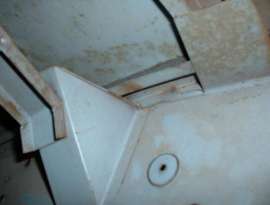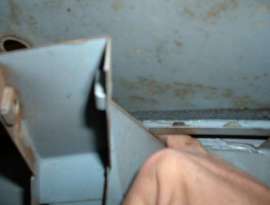The MGA With An Attitude
BOOT LID and BONNET HINGE Captive Nuts -- BD-120
On 07 March 2010, V Vassallo, Malta, wrote:
"I have one of the bolts on the bonnet hinge broken whilst another on the other hinge is seized and turning with the nut. Any suggestions by anyone who encountered this problem is appreciated".
Grind head off the screw to remove the hinge. Thread repair is not so easy, but is possible. The female thread (#10-32-UNF) is in a square floating cage nut. Find the sheet metal cage on top of the body pocket way up behind the dash. You might have to remove the dash for access. With a little luck you may be able to pry open one side of the cage to replace the square nut.
McMaster Carr sells #10-32-UNF (and #10-24-UNC) stainless steel square nuts with dome top (install flat side down). They also sell #10-24-UNC square nuts with flat top which would be the wrong thread pitch, but would work with matching screws. I would not recommend mixing thread pitches, some fine and some coarse, as this can only lead to future assembly problems. Even changing from fine to coarse for all nuts could confuse someone in the future when people are used to using fine thread screws for this application (and almost everything else on the car). The McMaster square nuts will be Grade 2 steel (when not stainless), so a better quality screw could strip the threads out of the nut with too much torque. You are not likely to strip the threads with a nut driver or screw driver, but it could easily be done with a 1/4" drive ratchet handle.
You can make your own square nuts with just a little fuss. Cut a 3/8-inch square blank out of 1/8-inch thick steel strap, then drill and tap the #10-32 thread. I have done that a few times as a matter of expediency, rather than waiting for a special order delivery. I do not know if you might find square nuts at a local hardware store. More likely stove bolts (cheap coarse threaded), but not so likely fine threaded.


On further inspection, the location of the cage nut is pretty much inaccessible, hiding inside of the transverse body brace channel (where the finger is pointing in the second picture). Before you start cutting and welding, I have another suggestion.

It may be possible to remove the cage nut (or nuts) by shearing off the sheet metal cage. You will need a special cold chisel to do this. Get a piece of square or rectangular steel bar about 12 inches long that will fit inside the body brace channel. Grind a 30 to 45 degree angle on the end to serve as a chisel point. Bend the bar slightly so the chisel end will lie flat on top of the hinge pocket while the free end will hang down a little. Making the chisel fairly narrow (maybe 1/2" square) could make it easier to shear the cage without damaging the pocket. Place the chisel point against the hidden sheet metal cage and drive it hard with a heavy hammer. If this works as planned it should dislodge the cage nut by shearing the sheet metal cage (or maybe breaking the spot welds).
Once the cage nut has been removed you can make a tapping strip from rectangular steel bar. This should be thick enough to nearly fill the vertical space, and just slightly narrower than the front to back space inside the channel, allowing the strip to float a bit for hinge position adjustment. Length of the strip should allow it to protrude slight at the end(s) where you can see it. Slip the strip into the pocket to the intended working position. In the engine bay, go through the screw holes in the pocket to mark locations for the tapped holes in the strip. Remove the strip to drill and tap #10-32-UNF threads. Re-insert the strip to verify proper alignment of the tapped holes where the hinge can be screwed in place. For final touch you may tack weld a mechanical stop (or two) inside the channel to keep the taping strip loosely in place, allowing it to float just enough for hinge adjustment.
If this is not successful and/or you feel the need to cut and weld, keep in mind the configuration of the parts here. Access to the underside is quite restricted inside the pocket. This could be easier if the body was inverted for work. If you want to cut through from the top, you will be passing through the outer body cowl, a felt packing strip (if the original piece is still there), and the body brace channel. When welding, keep the felt strip in mind as a fire hazard.
|